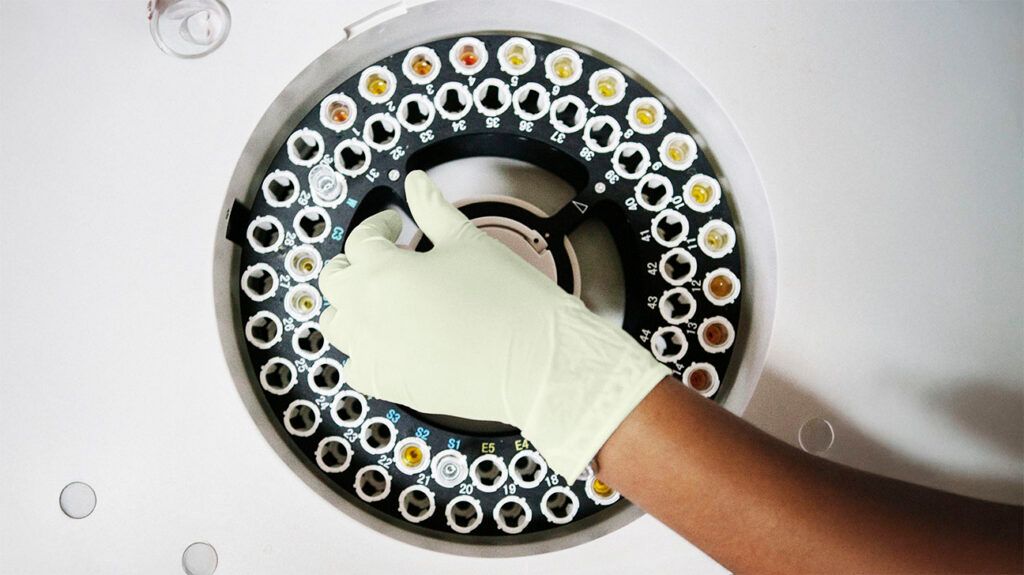Vampire facials involve piercing the skin with a needle. Reusing these needles across multiple clients or not taking other sanitary precautions could result in the transmission of HIV.
In
However, it is important to note that, overall, the number of HIV cases confirmed to be a result of this procedure is very low, and none have occurred in safe medical settings.
Keep reading to learn if vampire facials can lead to HIV, how many cases there have been, and what the risk is.

Yes, vampire facials can potentially lead to the transmission of HIV. However, this can only occur if the practitioner does not conduct the procedure safely.
HIV spreads when certain bodily fluids from someone with the virus enter the body of another person. This can include blood, semen, vaginal fluid, and breast milk.
Since PRP involves drawing blood out of the body with a syringe and then reinjecting it into the face, there is a risk of disease if there is cross-contamination between different clients.
Practitioners must ensure this does not happen. This involves:
- using brand-new, sealed, and sterile syringes for every procedure
- carefully labeling the blood to ensure it does not get mixed up with someone else’s
- keeping all equipment clean and sterile
- disposing of used syringes safely in sharps containers
The only recorded cases of HIV from vampire facials occurred at a specific unlicensed spa in New Mexico in 2018. In total, there were five cases that had a connection to the spa.
Two of the people were in a relationship and had more advanced HIV infections. A
The investigation did not find the specific action that led to the incident but discovered that the business had inadequate hygiene practices. For example, at the premises, the investigation found:
- unwrapped, nonsterile syringes on counters, in drawers, and in regular trash cans
- unlabeled tubes of blood
- tubes of blood and other injectables, such as Botox, stored in a fridge alongside food
Any of these practices could pose a risk of bloodborne disease transmission.
While these case reports are concerning, it is important to note that they are the only reports of HIV that have a confirmed connection to vampire facials.
Before
There could be other cases that experts do not know about, but the risk of this happening in a medical setting under the care of a doctor or dermatologist is low.
However, the risk of bloodborne diseases from procedures in non-medical settings can be higher. The American Academy of Dermatologists (AAD) emphasizes that it is unsafe to have cosmetic injectables, such as fillers, at:
- non-medical spas
- homes
- parties
- beauty salons
The risk is likely similar for other procedures involving injections.
Under safe, sterile medical conditions, vampire facials, or PRP, appear to be safe for many people.
Usually, the only side effects people experience are bruising, swelling, or tenderness in places where they receive injections. These side effects typically go away in a few days.
However, it is essential that those performing PRP handle the blood correctly and follow the same safety procedures as a hospital or blood transfusion center.
There are also some who should not have this procedure, including those with:
- HIV
- viral hepatitis
- any type of blood cancer
- skin cancer in the treatment area
- cardiovascular disease that requires someone to take blood-thinning medication
There are many things doctors do not yet know about PRP. For example, the potential long-term effects are unknown.
Vampire facials may be safe when a person has one from a qualified medical professional. However, there is currently not much scientific evidence they work to reduce visible signs of long-term aging.
A 2020 review of past research concluded that PRP may have modest effects on the skin’s appearance, texture, and wrinkles. Although many participants reported high satisfaction, the researchers found the degree of improvement was often under 50%.
The studies in the review also had some limitations. Because there was no consistent method of studying PRP’s effects and no standard way of administering it, it was difficult for researchers to compare the findings.
Dermatologists do not yet know how much blood to inject — or in what locations — to get the best results. To be sure of its efficacy, scientists need to test PRP facials on a range of people.
Another factor to consider is the price. In the United States, vampire facials can cost anywhere between $250 and $1,500 per treatment. Many people get three or more treatments, potentially making this an expensive option.
The uncertainty around vampire facials may mean this option is not worth it to some individuals.
People interested in trying a vampire facial need to speak with a doctor, such as a board certified dermatologist, about the potential benefits and risks.
A person needs to choose a doctor with experience of the procedure and good reviews from other clients. They also need to be wary of anyone making bold or unproven claims.
The AAD states that cosmetic procedures involving injections are medical procedures and should take place in medical settings under the care of a doctor.
If a person decides to go ahead with the treatment, they need to choose a regulated medical facility and not a spa or salon.
There are some recorded cases of HIV from vampire facials, also known as platelet-rich plasma (PRP) microneedling.
These cases were few in number and occurred at an unlicensed spa with unsafe practices. In a safe environment and under the care of a doctor, PRP appears to be safe for many people.
However, the safety of PRP therapy depends on the practitioner and the setting where it takes place. For this reason, people always need to consult a medical doctor or dermatologist if they are interested in trying it.

